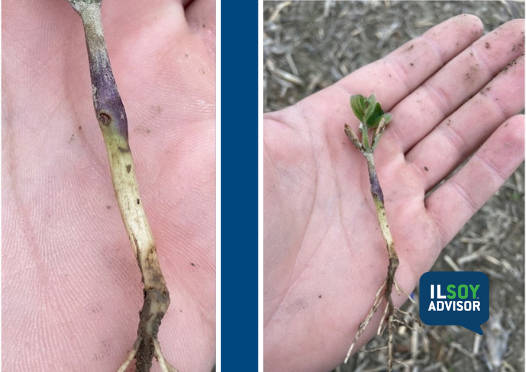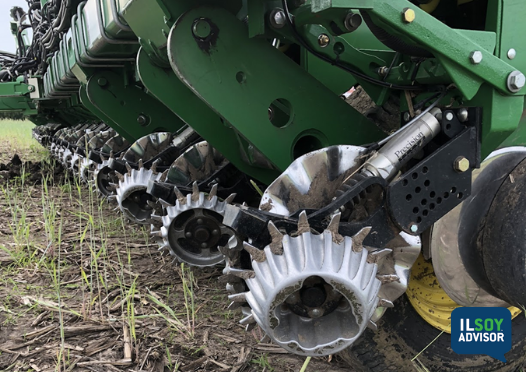ILSOYADVISOR POST
Agronomy: Does it pay to use a soybean seed treatment?
The popularity of soybean seed treatments did not come into play until around 2008. According to Dr. Gary Munkvold, Iowa State University, only about 8% of soybeans were treated in 2009. Today, we don’t have a good grasp on how many soybeans are treated, but we know it’s greater than 50%. Currently, around 92% of Burrus soybeans sold this year have seed treatment. Many credit earlier soybean planting, increased seed costs and higher commodity prices for the rise in soybean seed treatments.
Early planting
University research has taught us that earlier planting of soybeans is one way to get to higher yields and thus more value. But, earlier planting does not come without consequences. Those planting earlier in the season have a greater chance of soybean seeds or seedlings being exposed to cool, wet conditions, which increases the chance for exposure to disease and pests. Seed treatment is a way to protect your seed investment or “give assurance” that soybeans will be better equipped to endure harsher conditions.
Soybean stand establishment
Once soybeans are planted, stand is important. If stands are reduced, there is a chance of reduced yield potential. Many things such as crusting, compaction, flooding, planting depth, cold stress, residue, dry soils, herbicide injury and sidewall compaction, as well as low germination, can affect stand. The main things to impact stand, however, are seed rot and seedling disease. The greatest soybean yield robbers are pests such as soybean cyst nematode and Phytophthora, charcoal rot and Sudden Death Syndrome, along with many other seedling rots lurking in the soil. Annual yield loss from pests and diseases will vary year to year based on environment, but the one thing we do know is that seed treatments can protect your soybean seed stand.
What diseases are affecting soybeans?
We must assume there are soil borne diseases out lurking in our fields, but do we really know what is out there? A recent joint University survey conducted in the Midwest showed that Pythium was the greatest threat to soybean seedlings; 43 different species to be exact. This is interesting because many think that Phytophthora, a fungal like oomycete, is the main soybean soil borne disease. The study also found that there appeared to be less Rhizoctonia disease pressure affecting soybeans. Another facet of this survey revealed that many of the Pythium species had adapted to their location’s soil temperatures.
One key to combat early season soybean disease is to use high-quality seed. Other ways to help reduce seedling rots are crop rotation, drainage, avoiding stressful soil conditions such as compaction, or disease resistance. We have sources of resistance genes available for Phytophthora, but no primary sources of soybean resistance available for Pythium. Our only chance of protection against Pythium, an oomycete, is a soybean seed treatment that contains a fungicide component with activity against soil borne oomycete fungi.
A common misconception is that all fungicide seed treatments are all alike, but in reality a grower needs to make sure that their seed treatment consists of two or more active ingredients of fungicides to combat the many different seed and soilborne pathogens. Don’t be misled by trade names; know what you are buying.
Do I need an insecticide/nematicide in my seed treatment?
Nearly all soybean seed treatments contain insecticides such as clothianidin (Poncho®), imidacloprid (Gaucho®)) or thiamethozam (Cruiser®)) to control soybean aphid, bean leaf beetle, grape colapsis, white grubs, wireworms and three-cornered alfalfa hopper. The University of Tennessee observed between 2005 and 2014 that neonicotinoids (Gaucho or Cruiser) gave an average of 1 bu/an increase.
When glancing at research done by Iowa State, there were times when the response from a nematicide included within the seed treatment package varied, and in some instances it was thought that soybean cyst nematode pressure wasn’t high enough to bring about a yield response. Most soybeans variety already contain some source of soybean cyst nematode resistance.
Seed treatment = insurance
To be honest, over the past several years it has been extremely difficult to economically test and ascertain the presence of seed and seedling disease as well as pests. Therefore, it is difficult to predict yield loss at planting and prove the worth of seed treatment. To add to the confusion, we also have learned that the interaction of the seed treatment can vary based on different soybean varieties. However, it has become evident that the decision to use a seed treatment is more important than what soybean product is used. Because there are so many environmental variables, we need to have a mindset that a soybean seed treatment can be “insurance” for growers by increasing stands and yields around 75% of the time.
Reducing soybean populations and increasing your return on investment
The other area of focus that we turn to is soybean economics. By investing in soybean seed treatment, we can now start to reduce soybean seedling rates, especially now that we have had an increase use of pre-residual herbicides across the Burrus/Hughes footprint. Recent University of Wisconsin research was able to show that by using a soybean seed treatment and then lowering soybean seedling rate, you can begin to increase return on investment.
Today, much of my educational outreach covers broad pest and disease control as well as product combinations and comparisons of seed treatments. It is estimated that the seed treatment market will reach $4.45 billion by 2018 with a focus on multi-compound products that have a complete spectrum of pest and disease control with an emphasis on seed vitality, stress tolerance, nutrition, higher treatment quality and improved application.
Stephanie Porter is a Burrus Seed Sales Agronomist. Read more about Stephanie here.





Comments
Add new comment